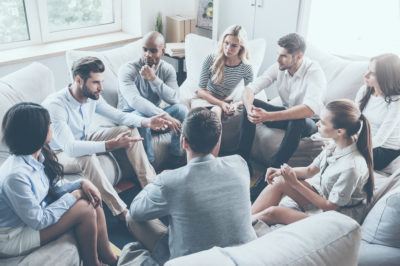
Fortunately, there is something you can do. It’s called an “Intervention,” and we’ve got five basic things to keep in mind about how properly conduct this activity. But first, let’s go over the basics.
What Is an Intervention?
An intervention is a controlled confrontation between an addict and the addict’s friends and loved ones. It is where the people closest to an addict band together and help to convince the addict that it is time to quit the substance and get rehabilitation. During an intervention, the people involved talk about how the addiction has changed things for the worse, provide a plan for rehabilitation, and—not as a threat, but as a promise—talk about the repercussions there will be if the addict refuses to seek treatment and continues to give in to the addiction.
There are some very important considerations to account for if you decide to have an intervention. Following these tips can help to make a difficult situation more manageable.
1 – Plan & Research
It’s not enough to simply confront an addict. You need a plan of action. You must look at how to conduct an intervention, and, if you have access, get the advice of an expert, such as a psychologist, a social worker, or even an interventionist that specializes in these activities. An intervention isn’t something where you can just “wing it” and improvise, hoping for good results.
You should also look at what your options are should the intervention succeed. Do not confront an addict, tell them to get help, and have them agree, only to not have any clear idea of where or how to get that help. All of this needs to be planned and researched in advance, so when the intervention happens, you have the answers.
2 – Assemble a Team
In the same way that you should plan for the specifics of an intervention, the same applies to the people attending it. This is not going to be a party with people dropping in and out while casual conversation occurs. This is a focused confrontation, with the people most invested and/or most effective at reaching out to the addict and enacting real change. This team should consist of a mix of family and friends. Everyone should agree to a place and a time.
3 – Don’t Make Idle Threats
One of the biggest components of an effective intervention is where the people involved making very clear points to the addict about what will happen should the intervention be refused, and the addict continues to take drugs or drink alcohol.
It is absolutely imperative that these conditions be real, and not threats, or ultimatums, idle or otherwise. There must be real consequences for an addict choosing the addiction over recovery, and you have to make sure these are real consequences that you can live with. If you want to move out, or have the addict move out if the intervention is ignored, for example, you must be willing to follow through. Everyone involved must make a similar level of commitment. “I’ll be very cross with you for a week” is not going to cut it in a situation like this.
4 – Make Notes and Know What You Want To Say
During an intervention, you will be making specific points and arguments, so make sure you know what these will be in advance. You need to point out to addict ways in which this addiction has been affecting their lives, and you will need specific examples that you can cite, not just vague descriptions of “It’s not good.”
Everyone needs to have a say in this. If someone doesn’t want to speak out, that person should not be present for the intervention. Remember that what you say should be helpful and concerned, not accusatory or angry. You are here to help the addict, not punish them or drive them away. It is also important to stick to the facts. Do not make the arguments more emotional than necessary. Addicts will usually miss appointments, run into financial problems, or other issues. Point these out, as they cannot be denied in the same way an emotional appeal can.
5 – Get Professional Help
If you’re feeling overwhelmed by the seriousness of an intervention and wish that someone with experience could guide you through the experience, you can get that. There are psychological and counseling professionals, and even specialists known as interventionists that can help.
If you don’t feel confident about being able to conduct an intervention without a professional present, there’s no need to do without. Seek out and secure the guidance of a professional, and make sure that all the arrangements are made with both the professional and whatever rehabilitation program you think is most appropriate for the person the intervention is for.
An Important First Step
An intervention is a crucial moment when you can pivot someone at risk from substance addiction to a new direction and recovery. This is likely to be an intense and even grueling experience for everyone involved, but it is necessary to get an addict to understand that people are concerned and that they want to help. However, the addict must make that critical decision to want to recover, and it is up to the people involved in the intervention to facilitate making that decision. If things don’t go as planned, Here’s what to do if an intervention fails.
When the decision has been made, checking into a rehabilitation program begins the actual process of recovery. There may be a period of physical withdrawal, depending on the substance of addiction, but it’s all part of the process and eventually leads to better things. Contact us for help with your intervention.
